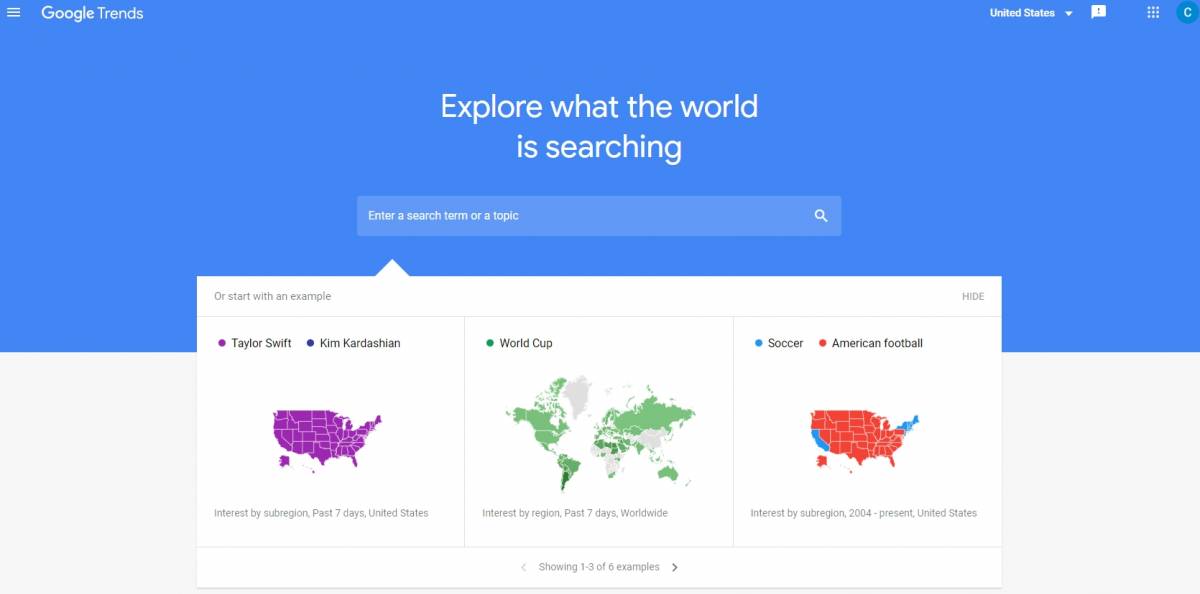Google Trends is an online data exploration tool that features real time search data from Google. Users can explore people’s search interests and find additional data like the most relevant articles, interest over time, interest by region, trending queries, and related topics. After you search a term, you will see a map which shows the regions where the term is most popular in the world. Users can also go back past and compare different terms from the year 2004 to the last 36 hours to understand relation between them.
 Google Trends screenshot
Google Trends screenshot
Tool Snapshot
| Price |
Free |
| Learning |
Social constructivism & Connectivism |
| Ease of Use |
★★★★☆ |
| Privacy |
★★☆☆☆ |
| Accessibility |
★★★☆☆ |
| Class Size |
Compare up to five groups and each group has 25 terms |
| ISTE*S |
Computational Thinker, Knowledge Constructor, Global Collaborator |
Price
Google trends is a free online tool.
Ease of use
Google Trends is simple and well designed website. Help center concisely expresses how to use the website step by step. There is no FAQ section, so users may not find a quick response for their questions.
Designers
Google was founded in 1998 by Larry Page and Sergey Brin Menlo Park, California, U.S. They moved to headquarters to the Mountain View, California in 2004 and called there as “Googleplex”.
Accessibility
Google apps supports screen reader, TalkBack, full page zoom, high contrast settings, and chrome accessibility extensions to increase accessibility.
Google Trends Overview Video
 Watch on YouTube
Watch on YouTube
***View the Google Trends Video Transcript***
Google Trends & the SAMR Model
Dr. Ruben Puentedura’s SAMR model offers a lens for examining how technology is adopted in a classroom. As you strive to incorporate online tools into your classroom, we encourage you to use this model as an analytic tool. Here is an example of how Skype might fit within the SAMR model:
- Substitution: Students use Google Trends to explore what is going on in the world instead of getting information through printed media such as magazine, book, and newspaper.
- Augmentation: Students can explore multimodal representations of datasets.
- Modification: Students can compare and contrast search engine data with ease.
- Redefinition: Students can explore real-time data about the public's interest in math, science, social studies, and other topics.
Learning Activities
Math
Students can analyze Google Trends graphs and charts to make informed decisions and identify patterns in the data.
Science
Students can explore trending science topics.
English/Language Arts
Students can write stories based on their interpretation of Google Trends data (e.g., comparing search results for Taylor Swift and Kim Kardashian).
Other
See 7 Ways to Use Google Trends.
Resources
How to Use Google Trends
- Go to Google Trends
- Click “Sign In” and at the top of right corner
- Then click on at the bottom of “Create an account” register for an account
- Return to “Google Trends” and sign in
- Setup your profile page
- Click on the people silhouette icon in the top right corner (next to the “Tweet” button)
- Click on “My account”
- Add a photo and change the settings to which you want
- Explore Topics to find what people have been searched recently
- Use an example which is given by Google Trends
- Click on one of the stories topics and see visual and written data
- Move mouse around the graphic and discover what the trends are in certain times
- Click on the map which is at the bottom of the page to explore interest of subregion
- Or click one of the “Trending queries” in the top right next to the map
- Compare the terms
- Search for a term like “Facebook”
- Then click on the “+compare” inside the topic box
- Add another term like “twitter” you want to compare then see the results
- Remove a term from the compare lists go to terms box then click the “X”
Research
Choi, H., & Varian, H. (2012). Predicting the present with Google Trends. Economic Record, 88(s1), 2-9.
Nevin, R. (2009). Supporting 21st-century learning through Google Apps. Teacher Librarian, 37(2), 35.
Vaughan, L., & Romero‐Frías, E. (2014). Web search volume as a predictor of academic fame: an exploration of Google Trends. Journal of the Association for Information Science and Technology, 65(4), 707-720.
Mavragani, A., & Tsagarakis, K. P. (2016). YES or NO: Predicting the 2015 GReferendum results using Google Trends. Technological Forecasting and Social Change.